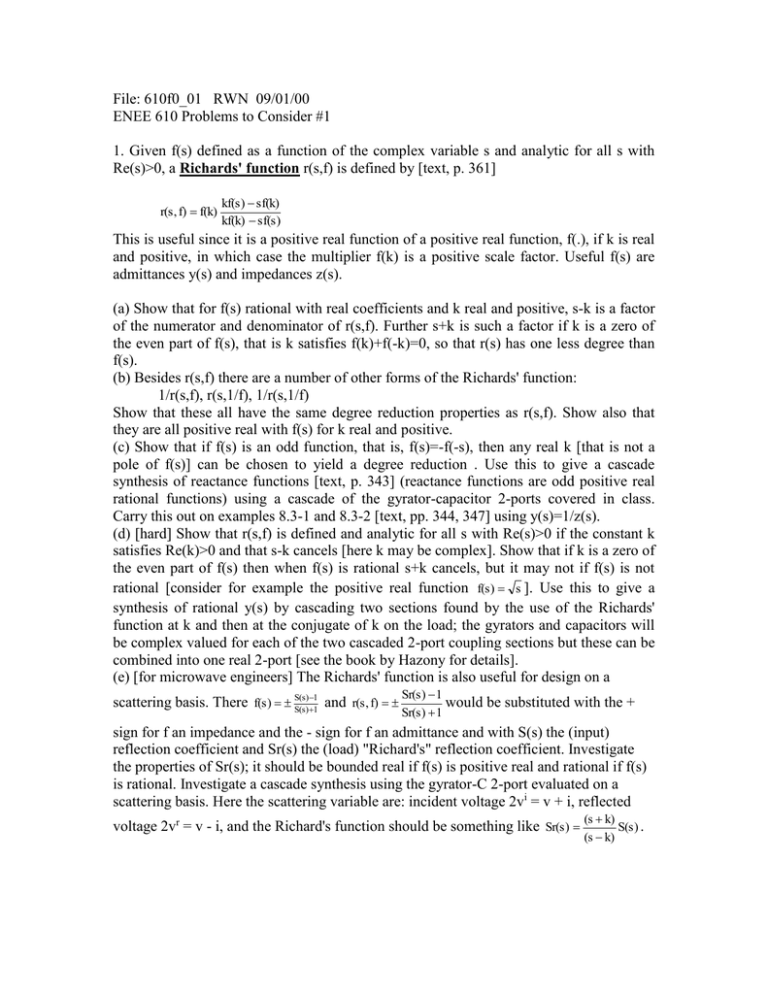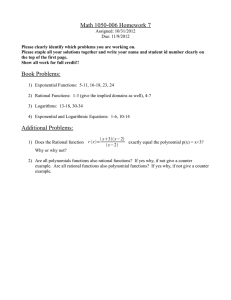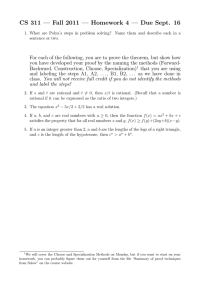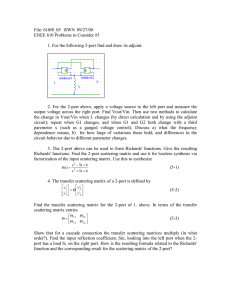610f0_01.doc
advertisement

File: 610f0_01 RWN 09/01/00 ENEE 610 Problems to Consider #1 1. Given f(s) defined as a function of the complex variable s and analytic for all s with Re(s)>0, a Richards' function r(s,f) is defined by [text, p. 361] r(s, f) f(k) kf(s) sf(k) kf(k) sf(s) This is useful since it is a positive real function of a positive real function, f(.), if k is real and positive, in which case the multiplier f(k) is a positive scale factor. Useful f(s) are admittances y(s) and impedances z(s). (a) Show that for f(s) rational with real coefficients and k real and positive, s-k is a factor of the numerator and denominator of r(s,f). Further s+k is such a factor if k is a zero of the even part of f(s), that is k satisfies f(k)+f(-k)=0, so that r(s) has one less degree than f(s). (b) Besides r(s,f) there are a number of other forms of the Richards' function: 1/r(s,f), r(s,1/f), 1/r(s,1/f) Show that these all have the same degree reduction properties as r(s,f). Show also that they are all positive real with f(s) for k real and positive. (c) Show that if f(s) is an odd function, that is, f(s)=-f(-s), then any real k [that is not a pole of f(s)] can be chosen to yield a degree reduction . Use this to give a cascade synthesis of reactance functions [text, p. 343] (reactance functions are odd positive real rational functions) using a cascade of the gyrator-capacitor 2-ports covered in class. Carry this out on examples 8.3-1 and 8.3-2 [text, pp. 344, 347] using y(s)=1/z(s). (d) [hard] Show that r(s,f) is defined and analytic for all s with Re(s)>0 if the constant k satisfies Re(k)>0 and that s-k cancels [here k may be complex]. Show that if k is a zero of the even part of f(s) then when f(s) is rational s+k cancels, but it may not if f(s) is not rational [consider for example the positive real function f(s) s ]. Use this to give a synthesis of rational y(s) by cascading two sections found by the use of the Richards' function at k and then at the conjugate of k on the load; the gyrators and capacitors will be complex valued for each of the two cascaded 2-port coupling sections but these can be combined into one real 2-port [see the book by Hazony for details]. (e) [for microwave engineers] The Richards' function is also useful for design on a S(s) 1 scattering basis. There f(s) S(s) and r(s, f) 1 Sr(s) 1 would be substituted with the + Sr(s) 1 sign for f an impedance and the - sign for f an admittance and with S(s) the (input) reflection coefficient and Sr(s) the (load) "Richard's" reflection coefficient. Investigate the properties of Sr(s); it should be bounded real if f(s) is positive real and rational if f(s) is rational. Investigate a cascade synthesis using the gyrator-C 2-port evaluated on a scattering basis. Here the scattering variable are: incident voltage 2vi = v + i, reflected voltage 2vr = v - i, and the Richard's function should be something like Sr(s) (s k) S(s) . (s k)








